Euroa MLA Producer Demonstration Site – Perennial Grass Comparisons and Management
On each property, a 10 hectare paddock was fenced into one hectare plots. Two replicates of five perennial grass species were sown into the one hectare plots (refer to full report appendix for site layout). The sites were sown in late autumn/early winter 2009.
Traditionally, semi-winter dormant (e.g. Australian) and winter active (eg. Holdfast) phalaris and some perennial ryegrasses had been used in the region. Perennial ryegrass did not survive the hot, dry summers. The phalaris was more persistent but was not tolerant of high aluminium, and the semi-winter dormant varieties did not adequately fill the autumn/winter feed gap. Neither option responded well to summer rainfall. The demonstration site species were chosen to address these issues, and are provided in Table 1.
Table 1. The place, purpose and known management requirements of Euroa Producer Demonstration Site perennial grass comparisons
| Plant | Place and purpose | Known management requirements | |
| Aluminium-tolerant winter active phalaris (Landmaster) | Deep-rooted, grows in heavier soils, tolerant of water-logging, high autumn-spring production and quality, persistent through hot/dry summers if allowed to go dormant. The main-stay of local production systems and a benchmark for less-known comparisons. Landmaster is an aluminium-tolerant alternative to other winter active varieties. | Requires rotational grazing (at three-four leaves) and seeding in the first year to stimulate summer dormancy. | 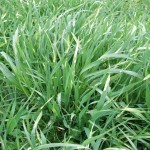 |
| Summer-dormant tall fescue (Flecha) | High autumn-spring production, aluminium tolerant, tolerant of hot, dry summers, provides a refuge if phalaris toxicity/staggers is an issue – otherwise a direct comparison to phalaris. | Requires rotational grazing (at three leaves) and spring management to maintain quality. | 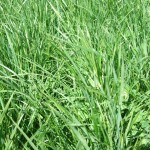 |
| Summer-active cocksfoot (Yarck) | Responsive to summer rainfall, lower winter activity than phalaris, persists on light, high acid soils. Not traditionally sown without other grass species in the mix, so interest was in how well it performed when managed according to its own requirements. | Requires rotational grazing (at three leaves) and careful grazing through summer to ensure persistence. | 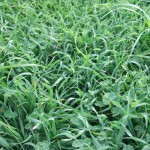 |
| Coloured brome (Exceltas) | Responsive to summer rainfall, maintains quality late in the season, relatively unknown production and persistence in the local environment. | Requires rotational grazing at the three-leaf stage. | 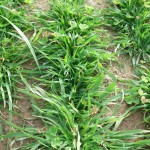 |
| Summer-dormant cocksfoot (Uplands) | Bred for lighter soils on hill country and tested in this environment for its drought and grazing tolerance, and production and quality through the growing season in comparison to phalaris. | Grows close to the ground and is more tolerant of heavy grazing. | 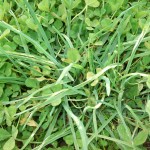 |
All grasses were sown with an early season sub clover (Urana) to guard against a failed spring and a mid season sub clover (Coolamon) to extend quality later into the season if moisture was available. These cultivars could not be obtained for the phalaris which was sown with Dalkeith (early-season) and Riverina (mid-season).
Additional monitoring sites
In addition to the plots, production (grazing days and tonnes of grain) was measured from a number of paddocks at the Longwood site, which were also established in 2009. These are presented in Table 2. Note the chicory was not sown with clover.
Table 2. The place, purpose and management of additional monitoring sites at Longwood
| Plant | Place and purpose | Known management requirements | |
| Grazing ryecorn (Southern Green)2 x 6.5 ha paddocks | Fast-establishing clean-up crop chosen to maximise winter production and reduce supplementary feeding costs while perennial pastures were being established on other parts of the farm. | A fast rotation to capture quality early in the season prior to heading. | 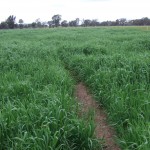 |
| Chicory (Puna) – 11 haNB: Volunteer annual ryegrass (Wimmera) made up a large proportion of this pasture in 2009, but did not return in 2010. | Deep-rooted, summer active, aluminium tolerant, relatively short-term alternative to lucerne, providing high quality feed for early-weaned calves. | Rotational grazing, allowing for seed set at the end of spring can increase longevity through re-seeding. | 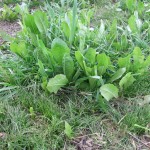 |
| Control (silver grass, wallaby grass, capeweed and sparse phalaris)15ha | Monitored as a base-case to the sown species. | Rotationally grazed throughout the demonstration. | 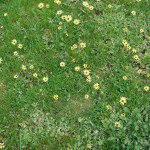 |
Establishment and ongoing weed and fertiliser management
The Longwood site was sown in the last week of May, and the Euroa site the first week of June, after a late break in 2009. The two sites had very different preparation in the lead-up to sowing.
The Euroa site was cropped with canola for three years and then with millet for the spring/summer prior to establishing the perennials.
The Longwood site was an unimproved pasture, dominated by silver grass and onion grass. It was sprayed for onion grass in winter 2008 before millet was sown the spring prior to establishing the perennials.
Both sites were sprayed with a knock-down herbicide (glyphosate) prior to sowing, and this was followed by a post-emergent broadleaf weed spray for toadrush and capeweed, and Lemat for red-legged earthmite control. Monoammonium phosphate (MAP) was applied at 100 kg/ha at sowing. A similar establishment regime was followed for the sown additional monitoring sites.
Following the establishment, silver grass was controlled with simazine and gramoxone in 2010 at Longwood, and broadleaf weeds were controlled at Euroa in 2012. No other spraying occurred for the duration of the trial. Soil tests were taken each year and fertiliser applied accordingly.
Management of the plots
At both sites, the plots were rotationally grazed by weaner cattle. Management is described below.
Post-establishment
The Euroa site was given a very light graze across all plots in early September following establishment, prior to setting up the fences, and a second graze in early October across all plots except Phalaris 2 as it was about to go to seed. The Longwood site was grazed more intensively (after the fences had been set up).
Rotations
The 2010 rotation for the ten plots at each site was worked out using the EverGraze Feedbase Planning and Budgeting Tools. The rest periods were based on leaf stage plant recovery (approximately 40 days in autumn, 60 in winter, 30 in spring) and plots were grazed to a minimum of 800-1200kg DM/ha depending on feed availability. In 2011, the rotation planner was used to a lesser degree, as the site owner’s became more experienced in assessing the pastures for growth and feed availability. In 2012, the rotations were completely worked out based on visual assessments and measurements taken every month, as well as cattle performance.
The control at Longwood was rotationally grazed with cows and calves on a similar rotation length to the sown plots, and was managed to leave 800-1000 kg/ha residual after grazing.
Cattle weights
The cattle on the sites grazed both plots of each species before being weighed, so that weight gains could be compared between species and cattle performance could be monitored, especially at key times such as winter. The stocking rates were adjusted based on both pasture availability and weight performance.
Measurements
A number of measurements were taken at the plots on a regular basis to monitor the performance of the perennials as well as the cattle. Where possible, the MLA More Beef from Pastures Tools were used to conduct and analyse measurements. The measurements were done by a contracted technical officer, who is also a member of the Euroa Grazing Group.
The measurements undertaken included:
- Soil tests taken in late summer each year.
- Pasture persistence in the form of plant counts which was done once a year, normally at the autumn break
- Pasture composition and ground cover % done seasonally (normally January, May, July and October)
- Pasture quality – FEEDTEST (2010 only) and estimated green vs. dead
- Pasture growth (kg/ha/day using the MLA pasture ruler) done monthly in the growing season, visual estimates were done over summer.
- Dry Sheep Equivalent (DSE) grazing days per hectare (ha) (date entry, date exit, number, type of stock and cattle weights in and out)
- Cattle growth rates (kg/head/day and kg/ha beef produced)
- Costs and income + grazing days from the ryecorn, chicory and the unimproved control at Longwood for comparison to the trial
- EverGraze Feedbase Planning and Budgeting Tools used to determine how long to leave the stock in each plot for the rotation.
Acknowledgements
Thanks to the site hosts Andrew and Caroline Walta and John and Mary Kelly for hosting the sites, managing the cattle movements, recording weights, rainfall, grazing data and above all their commitment and passion to this project. Thanks also to the members of the Euroa Grazing Group – the project would not have been such a success without the drive and enthusiasm of the group.
This project was funded by Meat and Livestock Australia (MLA) and the Agriculture Victoria as part of the MLA Producer Demonstration Site initiative. Significant linkages were made between the BESTWOOL-BESTLAMB and the EverGraze project to boost extension for the project. Smyth Seeds and Stephens Pasture Seeds provided seed for the trial sites.
Further Information
- Full report – Euroa Producer Demonstration Site
- Case study – Flexible approach fills the gap
- Case study – Perennials increasing productivity
- The place, purpose and management of perennials – Euroa Producer Demonstration Site, Grasslands Society Conference Proceedings 2011
- A simple guide to pasture establishment
- EverGraze Action – Growing and using Chicory on the East Coast
- EverGraze Action – Grazing Phalaris for production and persistence
- EverGraze Action – Growing and using winter active tall fescue in southern Australia
- Primefact – Cocksfoot

